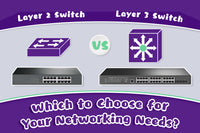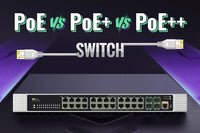Contents
How to connect more than one network device within a LAN network? The Ethernet switch is a common solution for enhancing network connectivity across local networks. Network switches come in different types, including PoE switches, modular switches, and KVW switches. If you’re planning to install or upgrade your local network infrastructure, what type of Ethernet switches should you choose? We’ll deeply explore the differences between managed and unmanaged switches in this article, helping you find the best option.
What is a Network Switch?
A network switch, also known as a switching hub, bridging hub, or Ethernet switch, is a type of network hardware used to enhance communication between different devices in local area networks. As is known to all, IT devices communicate with each other using data packets, and Ethernet switches are used for receiving and forwarding data using packet switching. The network switch can work at layer 2 or layer 3 of the OSI model.
(Notes: The Open System Interconnection (OSI) model, published by the International Organization for Standardization (IOS) in 1984, is a framework model explaining the functions of the network system. It contains a 7-layer architecture that consists of Physical, Data Link, Network, Transport, Session, Presentation and Application layers. Each layer in the OSI performs its defined function to ensure a smooth data flow and troubleshoot layers or certain components in the network.)

What is a Unmanaged Switch?
Unmanaged switches, featuring a plug-and-play design, are easy to deploy in the network. Simply connect them to the network devices, and then these devices can seamlessly communicate with each other. Unmanaged switches have no configuration setting, and they usually have auto-negotiated ports to determine data rates switch from half-duplex to full-duplex mode. Unmanaged switches have no features of (Virtual LAN) VLAN and options for layer 2 or layer 3. Using an unmanaged switch is just like using an old-style phone, offering only basic functionality and limited features.
An important feature of unmanaged switches is that they can maintain the MAC address, which enables them to establish separate collision domains.
What is a Managed Switch?
Managed switches are more manageable, configurable, and flexible. Managed switches provide a lot of functions in the network.
They allow users to customize each port with different settings to better manage and configure the network. By employing Simple Network Management Protocols (SNMP), managed switches serve the role of monitoring data transmission. If the device has something wrong or the network is in incorrect condition, the managed switch will send you a message to inform you. It also provides remote management and software-defined network (SDN) management to help solve network errors. The ports of a managed switch can be configured as trunks so that they can transport multiple VLAN frames across one link. The managed switch also features a redundancy function, which is beneficial if the Ethernet cables are disconnected or connected with the wrong port.
Managed vs. Unmanaged Switch: What are the Differences?
Managed and unmanaged switches differ in the following aspects:
- Control and Customization: Unmanaged switches feature a fixed configuration with easy deployment; whereas managed switches have more advanced features like VLANs and STP.Managed switches are more complex to deploy and require professional administrators to manage them.
- Performance: The managed switch is defined as a versatile device to control, monitor, and manage the traffic which benefits a lot to the network. Besides basic functions, it also possesses some additional functions like device optimization by the Quality-of-service (QoS). High bandwidth and strong ability to process data make it a useful tool in networks. The unmanaged switch owns only simple properties to ensure a normal network and cannot deal with too much data.
- Cost: Unmanaged switches can be more cost-effective for basic network requirements, but managed switches are the best choice for those requiring high-performance networks.Generally, managed switches can be more expensive than unmanaged types.
- Security: Unmanaged switches only feature the basic security mechanism, while managed switches usually feature VLANs and authentication to avoid potential threats and protect the data and devices. Managed switches offer robust security options to block unauthorized users and restrict access to certain parts of the network.
|
|
Managed Switches |
Unmanaged Switches |
|
Configuration |
A complex configuration including VLANs, DHCP snooping, SNMP, etc. |
A simple and fixed configuration |
|
Performance |
1. Strong ability to control, monitor, and manage data; |
1. Basic ability to ensure a normal network without any additional functions; |
|
Security |
Enhanced security |
Ensure basic security only |
|
Cost |
Relatively high cost |
Relatively low cost |
Managed vs. Unmanaged Switch: Which One Should I Choose?
Choosing between managed and unmanaged depends on your specific requirements for security and network performance.
In general, unmanaged switches are often seen in small networks like homes, small offices, or small business environments, as they can effectively handle the traffic generated by these small networks. The fixed configuration and easy deployment make unmanaged switches the optimal choice for these applications.
But if there is large traffic in the network at the same time, unmanaged switches are not able to handle them. Managed switches are used widely in large networks consisting of multiple network devices, such as medium or large corporations or organizations. The VLANs of managed switches can help divide LAN into different broadcast domains for optimal network performance. In addition, managed switches are also very suitable for those with high requirements of security and large sensitive data.
Some people are confused if they should use managed or unmanaged switches for gaming. Typically, for most gamers with home networks, an unmanaged switch is enough. But if you own a more complex network and want to get the best gaming experience, a managed switch is a better choice with high speed and security.
Conclusion
Both managed and unmanaged switches have their place in networking and each is designed for specific needs and environments. Whether you choose managed switches or unmanaged switches, the proper network switch management will benefit your network.
FAQs
When should I choose the managed switch?
In scenarios with high workloads, high traffic, and high security, a managed switch is always the best choice.
Does the Unmanaged switch support PoE?
Not all unmanaged switches support PoE. If the switch does support it, it is usually labeled with PoE.
Is the network switch the same as a router?
They have some differences. The main difference is that the network switch is designed to connect multiple devices and networks to expand or create the LAN while a router helps connect one network to another.
For more information on this topic, you can keep up on our blogs. While VCELINK offers general and basic information for our customers and other visitors to the website, it’s not professional advice.



Be the first one to comment.
Leave a comment